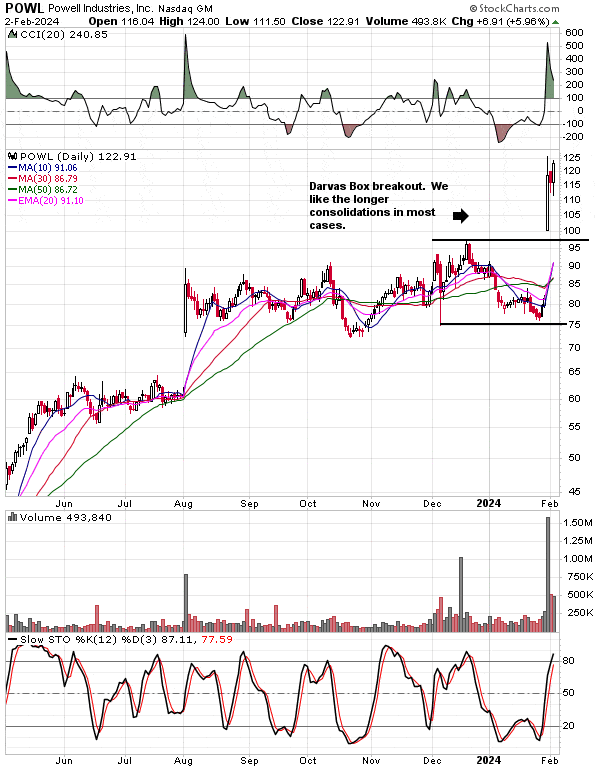Darvas Box Strategy and Earnings
Nicolas Darvas was a professional dancer and part time trader and is famous for turning $10,000 into $2 million more than 60 years ago trading stocks. His Darvas Box strategy was revealed in a book he later wrote that became very popular.
In his writings, Darvas stated that his strategy works in bull markets and not bear markets which is generally the case when trading breakouts. He also emphasized finding stocks that will “become the next IBM and not IBM itself”.
Its a good time to go over this strategy, which is similar to other top trend following strategies, as it may become very effective again as the Nasdaq nears a breakout into all-time highs.
Once the Russell 2000 turns higher and gets within 10% of the all-time highs, this strategy could do really well, in fact. We will just be adding a few adjustments to the strategy for the modern market.
Today we will talk about some of the differences between the Darvas Box strategy and the similar flat base breakout strategy covered in the last blog post. We will also talk about one of the best Darvas box breakouts this quarter and what we like about these breakouts over the others.
What is the Darvas Box Trading Strategy
In a bull market, the strategy calls for looking for stocks that could be the next Microsoft, Apple, Home Depot, McDonalds or the next big thing. In other words, usually small to mid cap stocks that could change an industry or even the way we live over the long-term and have exciting stories. After inflation, the definition of a mid cap should really change over time.
Nowadays technological advancements are so complex that it often takes an already large, sophisticated company to even come up with the innovation. Although its sometimes a larger company that spins off a new company focusing on the development of an up and coming new product or service that over time has exceptional long-term performance.
In any case, he said he wanted a stock that could triple or quadruple in the next bull market.
So a big part of the Darvas box strategy is finding great stocks with strong future potential to begin with.
He liked to find stocks that recently hit new highs and then formed a Darvas box pattern a little below the highs. This is similar to the Jesse Livermore approach. Professional momentum traders will tell you to focus on relative strength first and foremost on stocks near highs.
SMCI just made one of the biggest moves of all investable stocks last month as it was breaking into all-time highs out of an ascending base. Most of the move occurred after the breakout out of a long consolidation into highs after we recently featured it to customers.
Darvas would then find those most promising stocks that had this obvious long-term uptrend and look for box formations. The box is formed by at least 3 days of not making new daily highs, i.e. – staying below that resistance.
He would then buy “a few points above that resistance” on the breakout. His stop-loss would be placed about 5% to 10% below the entry point depending on the trade and he would raise the stop to about 5% or so below the next box formation.
Darvas Box versus a Flat Base
Its interesting to note that we have found that at least 3 day consolidations are usually best for high tight flags. The high tight flag could be thought of as a Darvas box with an extremely strong uptrend leading into the narrow consolidation.
If the price move is not 90% from low to high over the prior 2 months into the high of the Darvas box, we would avoid this type of breakout. Unless there is some very strong fresh news just before the breakout.
One of the key indicators that Darvas looked for was unusually high volume near the entry point. More about this below. This was back in the day before emails, smart phones and everything being recorded basically. So the volume was used as an indicator of insider trading before big news.
In the IBD strategy, they require at least a 5 week consolidation in most of the consolidation patterns they trade. We have found this to be better as well outside of the strongest trends such as with the high tight flag pattern.
Darvas Boxes and Earnings
Darvas does not really talk about earnings breakouts in detail in his books. This is probably the biggest key, however, to successfully using this strategy based on our experience.
Back in the day, the big earnings news could be disseminated ahead of time without it being recorded. So its my theory that insider trading was more rampant back then. If you talk to some old timers, they will tell that those who made money “knew something” ahead of time.
This is actually a lot more difficult nowadays and we are noticing some of the biggest moves are being made after the news and outlook is released. In either case, its difficult to know whether a company will increase guidance or not, how the margins will turn out and other key forward looking factors that will determine the direction of the stock after the news.
So the Darvas box strategy is working for us when we employ the following strategies.
Our Darvas Box Strategy
One of the best things you can do during earnings season is either look for stocks over $20 that are up the most after hours. Or, check the Zacks earnings calendar after hours to see which companies beat their earnings expectations by the most. We do both each day.
Then look for a Darvas Box pattern on a long-term chart for the stock. If the 50 day and 200 day moving average are rising as well with the 50 day above the 200 day moving average, you may have something.
Then we dive into the press release and earnings report, look at the multi-year trend, growth metrics, volume, industry relative strength, and other factors to know if we have a big trade brewing potentially the next day.
This is how we found SMCI recently just before an explosive move higher. Although in that case it was a pre-announcement where the after hours scanning brought it to our attention because it was up so much after hours.
The best opportunities are generally up the most after hours.
Darvas Box This Week
This is how we found POWL for customers last week. The stock had a huge earnings beat and great outlook. The price was in a great long-term uptrend and breaking out of a Darvas box and flat base pattern after hours.
In the daily alert, we featured the stock Tuesday evening and said to look for the price to reach a certain level before getting long going for a 15% to 20% profit. It reached the entry point at around $100 and quickly soared 23% from there.

Charts courtesy of StockCharts.com
The price reached the entry point first thing the next morning, would have held a 1% stop-loss below the technical entry point, and then hit our price target within a couple hours. A great 1 day 15% profit for those using our entry and exit targets.
ASH had a bigger beat that day but without the great long-term trend. POWL easily outperformed ASH after the news. The stocks in a great long-term uptrend tend to perform a little better overall with a higher win rate especially after holding it for a few days.
But these opportunities come up more often during earnings season which is the best time for retail traders to make money in our opinion. We have several weeks of earnings season to look forward to. In fact, early March is when you see some of the best young growth stocks report.
The piece missing from the Darvas box strategy is the earnings catalyst right before the breakout. Perhaps the market was trading differently back in the day. Traders and investors could not check the pre-market activity from their smart phone each day. Thinkorswim and simulators were only a twinkle in some young ambitious traders eyes back then.
Darvas Box That Did Not Work
2 other stocks that could be thought of as Darvas boxes featured in the alert service are not working – at least not so far. The key difference? Unlike the other big winners last month, these stocks did not have a fresh catalyst just before they reached a good technical entry point. An important piece of the puzzle we have been harping on over the past couple years in the alert service.
PANW was in a similar pattern and reached the entry point with fresh news last month. It soared over 20% from our entry trigger for customers quickly while holding a very tight stop-loss below the technical entry point.
Volume was not enormous at the entry point but the fresh news could be seen from the watch list on the subscription site by just checking your watch list stocks each morning. So the fresh news and the length of the consolidation are 2 examples of missing pieces for us in the Darvas box trading strategy.
Of course, we want to analyze the news and decipher the difference between ok news and very bullish news. In the next blog post we will be talking about some of the things we look for in an earnings release.
Darvas Box Drawbacks
Again, the Darvas box strategy can work well in a bull market on the best stocks. We would not use them on just any stock. Use them on penny stocks or options and you could wreck your account quickly.
If the Nasdaq composite reaches new highs and the small cap Russell 2000 surges 20% to reach new all-time highs, this strategy may do really well again. Darvas made most of his money during a strong bull market.
Another potential drawback to the Darvas box strategy is that the strategy takes time each day. For most busy professionals, a good ranking strategy may be the right swing trading strategy as it takes much less time overall on only 1 day per week. Our favorite is the 3 Stocks to Wealth strategy on investtobefree.com. Its off to another good start in 2024.
After More Than 10 Thousand Trades over 15 Years, These 3 Strategies Ranked Best
How We Trade an AI Super Stock
Learn Our Favorite Ranking Strategy for Stocks




